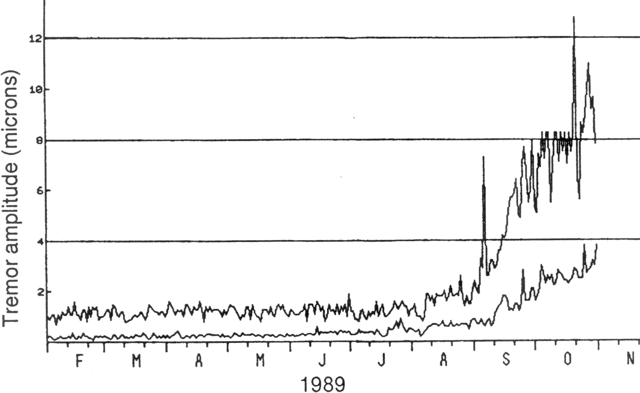Report on Asosan (Japan) — October 1989
Scientific Event Alert Network Bulletin, vol. 14, no. 10 (October 1989)
Managing Editor: Lindsay McClelland.
Asosan (Japan) More explosions; stronger tremor; new vent
Please cite this report as:
Global Volcanism Program, 1989. Report on Asosan (Japan) (McClelland, L., ed.). Scientific Event Alert Network Bulletin, 14:10. Smithsonian Institution. https://doi.org/10.5479/si.GVP.SEAN198910-282110
Asosan
Japan
32.8849°N, 131.085°E; summit elev. 1592 m
All times are local (unless otherwise noted)
Recorded explosions became more frequent in mid-October, occurring almost every day during the second half of the month (see table 4), for a total of 29 since 16 July. Minor ash emission occurred on most days in October, causing ashfalls around the crater. Ash reached AWS during favorable wind conditions, and by 21 October had accumulated to 3 cm depth (11,409 g/m2). On 27 October, 8437 g/m2 of ash was deposited at AWS, and slight ashfall was observed at Kumamoto Local Meteorological Observatory, ~35 km SW of Aso. The heavy ashfalls damaged agricultural products. A zone within 1 km of the crater remained closed to tourists by the Aso Disaster Authority.
Block ejection, to 10 m height, from Vent 891 was first seen during a 6 October field survey. During 9 October fieldwork, a new vent (named 892) about 1-2 m in diameter was observed about 10 m N of Vent 891, intermittently ejecting fist-sized blocks to 20 m height. Ash emission continued from 891 vent, but no blocks were ejected. The next day, Vent 892 had grown to ~5 m in diameter. By 21 October, the new vent had enlarged further to 25 m across, coalescing with 891 the following day.
Flames from burning gases rising several tens of meters from the vent were often seen at night. Strong rumbling was sometimes audible at AWS, and rumbling was heard 10 km to the ESE (at Takamori) during the 28 October eruptive episode.
The number of isolated tremor episodes increased toward the end of October (figure 16). The amplitude of continuous tremor, recorded by a seismograph 0.8 km W of Crater 1, grew particularly large from mid-October, reaching a maximum of 12.8 µm on the 21st.
 |
Figure 16. Daily maximum and average amplitudes of volcanic tremor episodes, 1 February-10 November 1989. Courtesy of JMA. |
Geological Summary. The 24-km-wide Asosan caldera was formed during four major explosive eruptions from 300,000 to 90,000 years ago. These produced voluminous pyroclastic flows that covered much of Kyushu. The last of these, the Aso-4 eruption, produced more than 600 km3 of airfall tephra and pyroclastic-flow deposits. A group of 17 central cones was constructed in the middle of the caldera, one of which, Nakadake, is one of Japan's most active volcanoes. It was the location of Japan's first documented historical eruption in 553 CE. The Nakadake complex has remained active throughout the Holocene. Several other cones have been active during the Holocene, including the Kometsuka scoria cone as recently as about 210 CE. Historical eruptions have largely consisted of basaltic to basaltic andesite ash emission with periodic strombolian and phreatomagmatic activity. The summit crater of Nakadake is accessible by toll road and cable car, and is one of Kyushu's most popular tourist destinations.
Information Contacts: JMA.

